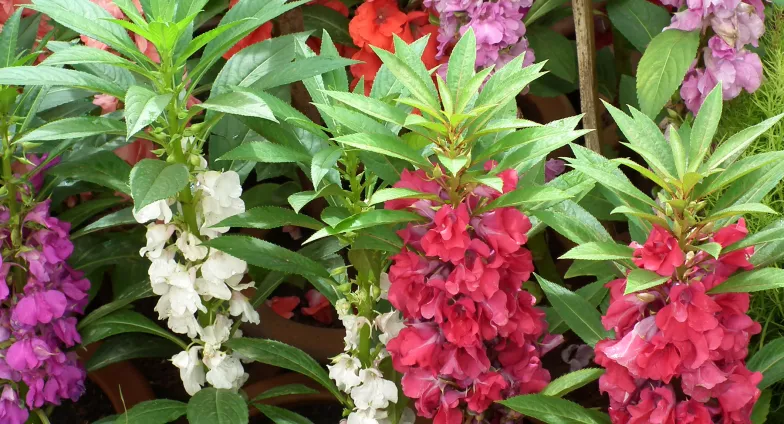Balsam: A Forgotten Garden Treasure
It’s always fun to grow something different in the garden. This year you may want to try a flower from the past. Balsam is a charming, heirloom flower with delicate blooms. Bees love balsam and so will you!
Balsam (Impatiens balsamina) was treasured by gardeners in the early 1900s but seems to have been forgotten. You won’t find balsam plants at most garden centers this spring when you look among the marigolds, petunias and impatiens.
Even if a garden center offered balsam, you probably would not give it a second look. When it is young, all you see is a single stem covered from top to bottom with pointy leaves. There are no flowers to draw your attention. Perhaps its inconspicuous appearance as a young plant is why few gardeners have discovered balsam.
Balsam is an easy to grow annual. It adapts well to both sunny and partially shaded conditions. Balsam grows especially well in sunny sites that are out of the harsh afternoon sun.
Balsam may be planted in containers or in garden beds. Seeds may be started indoors or directly sown in the garden.
The plants are sturdy, upright and narrow, growing about 12 to 36 inches tall. Blooms come in shades of pink, red, white and light purple.
The flowers may be a little hard to see as they are nestled between the leaves along the stem. Some gardeners pick off a few of the leaves to reveal more of the flowers, but I prefer the natural look of balsam. Bees and hummingbirds have no problems seeing the flowers. They love balsam.
We tested two varieties of balsam, ‘Camellia-Flower Mix’ and ‘Bush Mix’, in the 2020 North Dakota Home Garden Variety Trials. Most of these gardeners had never heard of balsam before. Each variety received high scores and enthusiastic recommendations from gardeners. Comments included:
“This is my first-time growing balsam and I loved it! It was loaded with bees and hummingbirds! I will be adding this flower to my pollinator garden next year! … Both varieties were very healthy and bloomed like crazy!”
“Both varieties grew extremely well and were an amazing addition to the garden … Both made a very impressive floral display both in garden and as cut flowers. The absolute best part—the bees loved both varieties.”
“Both varieties were pretty. It made me think I was vacationing in Hawaii. This was my first try at planting balsam! It was fun planting something different!”
“I had never grown balsam and didn’t know what to expect. These plants performed beautifully. … None of the plants developed disease and they bushed out nicely and bloomed for a long period. Both had a nice variety of colors. I’m glad I tried balsam and would grow either variety again.”
“I had never heard of this flower. Very hardy, pretty flower. … They were the best flowers I had of all my tests.”
“Balsam was a hardy plant that was able to stand the winds in our area. … They were great for fillers in flowerpots and adding interest in the garden.”
“It had strong stems for a vase arrangement. I had not grown balsam before but will add it in the middle of my plantings.”
“This was my first experience with balsam. Despite the heat and dry summer, both varieties did very well. They were very colorful, 3-foot plants. The seed pods were interesting, and I saved a few to plant next spring. Balsam is a lovely addition to any garden!”
These gardeners were surprised and enchanted by balsam. You may wish to give this heirloom a try yourself. Both you and the bees will be delighted.
Written by Tom Kalb, NDSU Extension Horticulturist. Photo courtesy of Rameshng.

